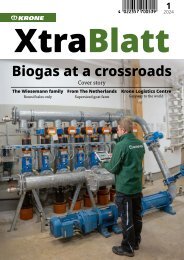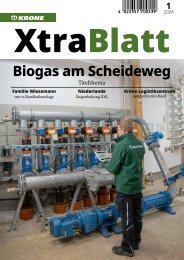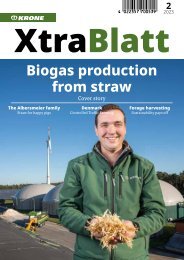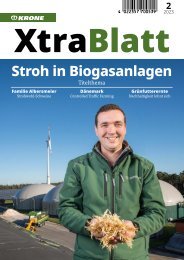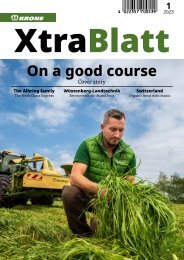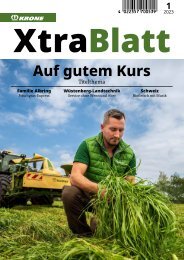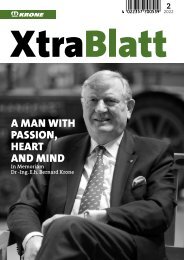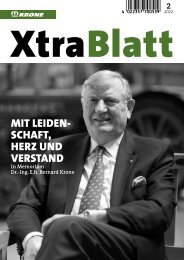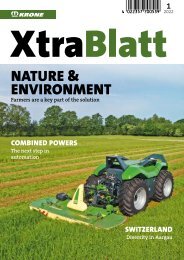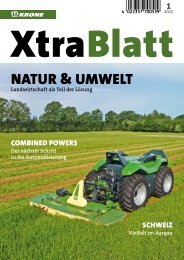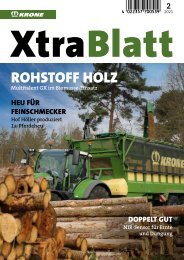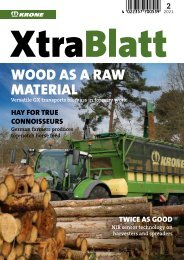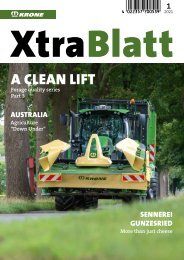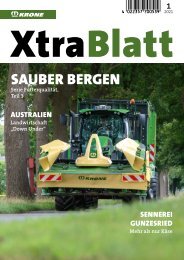XtraBlatt Issue 02-2020
You also want an ePaper? Increase the reach of your titles
YUMPU automatically turns print PDFs into web optimized ePapers that Google loves.
INFORM<br />
Museum – for many, the term<br />
indicates something a little dry<br />
at first, and perhaps boring. But here in<br />
Spelle, the Krone Museum is nothing of the<br />
sort! With fascinating exhibits, appealing<br />
presentations and clear explanations via<br />
multimedia technology, history can in fact<br />
be very exciting. Also particularly for younger<br />
folk. “After all, tradition and history don’t<br />
mean worshipping the ashes but instead,<br />
passing on the blazing torch. In other words,<br />
those who know nothing about the past<br />
cannot understand the present, nor can<br />
they create the future. This wisdom from<br />
the former German Chancellor Helmut Kohl<br />
applies not only to politics, it’s right for all<br />
fields of life. For instance, for the Krone<br />
Group and its history of 114 years. This is<br />
why it’s up to older folk like us to pass on<br />
our knowledge and, with help from younger<br />
generations, to prepare it in such a way that<br />
the information ensures understanding<br />
across the generations”, explains Walter<br />
Krone, cousin of Dr Bernard Krone and thus<br />
member of the third family generation since<br />
the firm’s founding in 1906. Walter Krone<br />
worked in the family concern for some 40<br />
years, initially in the machinery factory then,<br />
from 1977 to 2003, as managing director of<br />
the Krone trading division “Landmaschinen<br />
Vertrieb Dienstleistungen Bernard Krone”,<br />
abbreviated as LVD.<br />
He didn’t hesitate when his cousin Bernard<br />
asked him to coordinate the “Project Museum”<br />
and the associated working group. In<br />
2015 the LVD moved into a new building<br />
in the south of Spelle and soon afterwards<br />
the tradition-steeped meeting house in the<br />
community’s centre, parts of which stretch<br />
right back to the beginnings of the factory,<br />
was reassigned as museum with numerous<br />
exhibits moved-in. “Alone the sight of the<br />
numerous machines and implements under<br />
that roof was immediately impressive, representing<br />
a first big step forward”, recalls<br />
Walter Krone. “But it soon became clear<br />
to us: this alone was not enough. For the<br />
right effect, a completely different concept<br />
was needed. And this is what we’ve been<br />
working on intensively since 2017.”<br />
“We” in this association includes the<br />
working group of around 20 people and<br />
comprising Krone family members, representatives<br />
of external services and a<br />
number of machinery factory colleagues,<br />
retired or still employed. “Such a mix of<br />
different experiences and competences was<br />
very enriching for the project, just as for me<br />
personally”, he remembers. By February<br />
2<strong>02</strong>0 everything had been completed. The<br />
“new” museum was ready for opening –<br />
and then came corona. “That was certainly<br />
disappointing because we had all looked<br />
forward to a wonderful opening, and to the<br />
reactions from as many visitors as possible”,<br />
says Walter Krone.<br />
INSPIRING<br />
However, he and especially his honorary<br />
helpers from a circle of former colleagues<br />
including Franz Feismann, Georg Holterhues<br />
and Josef Börger, did not allow themselves<br />
to become discouraged. From April onwards,<br />
guided tours have indeed welcomed regular<br />
visits. After advance registration they come<br />
in small groups of all ages under compliance<br />
of full precautionary measures. The<br />
groups learn all about the exhibition and<br />
have been – as hoped – deeply impressed.<br />
“Especially with the slightly older visitors,<br />
many of whom often know exhibits from<br />
their own experience, the discussions that<br />
develop become so animated that a guided<br />
tour planned for two hours duration quickly<br />
runs to three hours and even more”, smiles<br />
Walter Krone. “But the younger visitors also<br />
show great interest when the context of<br />
respective exhibits is graphically explained.”<br />
Apropos explaining. Here it’s sometimes<br />
amazing how apparently self-evident things<br />
cause great wonder. Walter Krone speaks of<br />
the short films shown at the beginning of<br />
each visit. Among the subjects is machinery<br />
from the present company range with their<br />
respective applications. “Particularly those<br />
with no, or at least no close, relationship<br />
to agriculture often don’t know anything<br />
about the basic work being carried out – for<br />
instance in harvesting forage. So, at the end<br />
of the films we can get amazed reactions<br />
such as: ‘At last, I understand what these<br />
machines really do’. Often, applause breaks<br />
out at this point – which is very welcome<br />
indeed”, laughs Walter Krone. Similarly, he<br />
takes great interest in the visiting school<br />
classes. After all, during their guided tours,<br />
many children learn about working methods<br />
with tools they are seeing for the first<br />
time in their life.<br />
On show in Spelle: the world’s<br />
only working example of the<br />
Lanz Landbaumotor with<br />
integrated rotary cultivator.<br />
Among the highlights<br />
in the museum: a huge<br />
collection of historical<br />
tractors.<br />
Important in the museum’s conception, he<br />
continues, is the interesting mixture of differing<br />
experience dimensions – modern and<br />
from the past, general contemporary and<br />
personal family histories, real exhibition<br />
objects and virtual presentations. Thus, we<br />
can visit the office of the second Bernard<br />
Krone, as well as see household utensils<br />
from the 1950s and 60s. “After all, not only<br />
the machinery factory and the trading<br />
business belonged to the concern, there was<br />
a hotel too – even a household goods shop<br />
run by Dr Krone’s mother, Gertrud. Here, for<br />
instance, came many folk from the region<br />
before they got married, perhaps to buy<br />
crockery with their dowries, and seeking<br />
her advice in Spelle,” he relates.<br />
UNIQUE<br />
The great attraction of the exhibition is –<br />
how could it be other – the machinery. To<br />
this belongs all the machines ever built by<br />
Krone, including prototypes that never went<br />
into series production. Figuring among the<br />
highlights are also the innumerable old<br />
timers, sometimes extreme rarities to be<br />
seen nowhere else. As one example from<br />
many, Walter Krone names the 1917 produced<br />
Lanz Landbaumotor with integrated<br />
rotary soil cultivator. He says this is the only<br />
functioning example worldwide. Another<br />
One hundred years ago a the well-known nickname for the smallest Hanomag 2/10 car was “Kommissbrot”:<br />
its main components jokingly referred to as “2 kg of tin and a lick of paint”.<br />
rarity is one of the first John Deere combine<br />
harvesters, from 1940. The precisely<br />
restored model in the museum is the only<br />
example of this type in Europe.<br />
These two machines count among Walter<br />
Krone’s personal favourites. “In fact, I actually<br />
have seven favourite highlights here.<br />
My, one can say, BiG 7 – because, as is well<br />
known, we have a thing about BiG in Krone.”<br />
The other five include a six-furrow motor<br />
plough and a very old mower cutterbar,<br />
the latter as synonym for the massive importance<br />
of mechanisation in agriculture.<br />
The cutaway model of a threshing machine<br />
from Ködel & Böhm is also well up on his<br />
BiG 7 list, as is a hand-powered winnower<br />
from the 19th century with hand-carved<br />
cogwheels. Last but not least is one of the<br />
first Hanomag serial tractors, of which the<br />
LVD sold hundreds in its day. “But in reality,<br />
most impressive to me is the collection as<br />
a whole, along with the fact that, working<br />
together, we have succeeded in presenting<br />
everything so well in the Krone Museum.<br />
Now it’s really good.” «<br />
44 45



